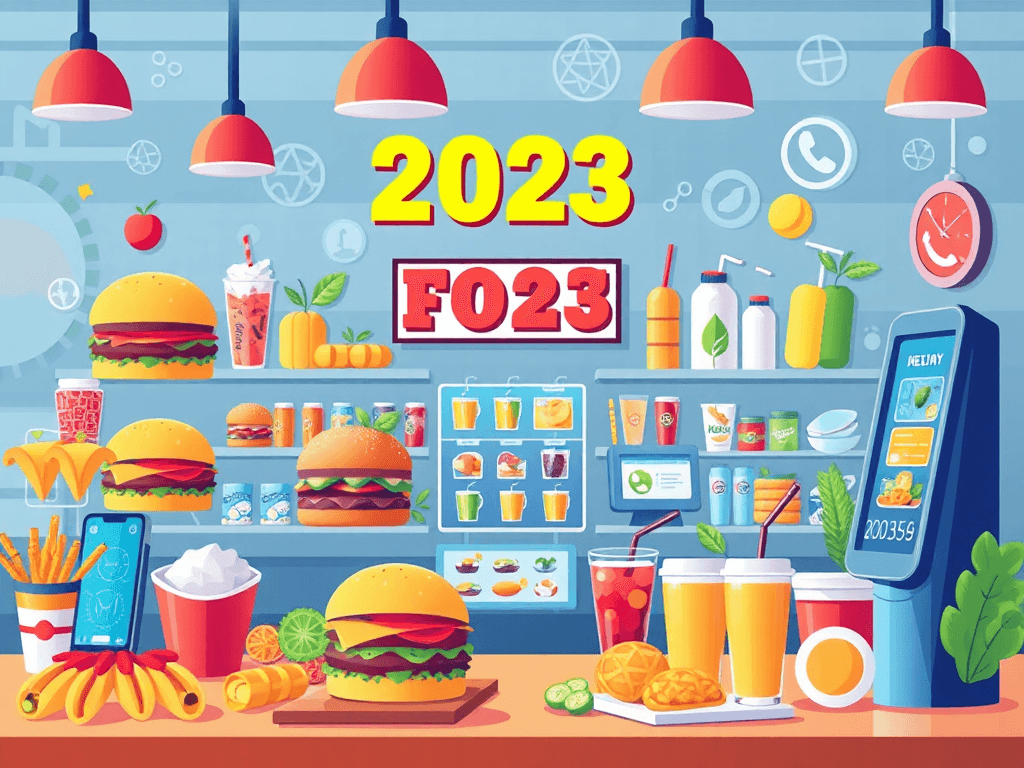Fast Food and Beverage Industry Trends (2023)
By RG team · 10 min read
Last Updated on May 21, 2023
Wait a minute...

The food and beverage industry is constantly evolving, with trends and consumer preferences shifting from year to year. As we approach 2024, it's important for business professionals and consumers alike to stay up to date on the latest trends and predictions for the industry. In this article, we will discuss the key trends that are expected to shape the fast food industry in the years to come, including the fastest foods in the world, the fastest fast food restaurants, the need for healthy options, the importance of technology, and the future of fast food. Whether you're a die-hard fast food fan or a health-conscious consumer, this article will provide valuable insight into the changing landscape of the food and beverage industry.

Photo by Kevin Lanceplaine on Unsplash
The Top 10 Fastest Foods in the World
Fast food is all about convenience and speed, catering to our busy lifestyles and on-the-go mentality. But what are the fastest foods in the world? Based on our research, we've compiled a list of the top 10 fastest foods:
Sushi: Fresh, delicious, and quick to prepare, sushi is a popular choice for those looking for a fast and healthy meal option.
Pizza: With its simple yet customizable ingredients, pizza can be whipped up in no time and is a classic fast food option.
Hot Dogs: A classic fast food staple, hot dogs are easy to prepare and can be customized with a variety of toppings to suit any taste preference.
Tacos: Whether it's a traditional street taco or a Tex-Mex style taco, these handheld meals are easy to make and quick to eat.
Burgers: From fast food chains to gourmet burger joints, burgers are a go-to choice for those in search of a quick and satisfying meal.
Sandwiches: Whether it's a classic PB&J or a gourmet panini, sandwiches are a versatile and convenient option for those on the go.
French Fries: While they may not be the healthiest option, French fries are a popular side dish that most fast food joints offer.
Fried Chicken: Fried chicken is a classic fast food option that is quick and easy to prepare, and popular all around the world.
Smoothies: For a healthy and refreshing fast food option, smoothies are a great choice. Packed with vitamins and nutrients, they're easy to make and can be customized to suit any taste preference.
Ice Cream: Whether in a cone or a cup, there's nothing like a sweet treat to satisfy your cravings. Ice cream is a quick and easy dessert option that's perfect for those on the go.
While some of these options may be less healthy than others, they are all a popular choice among consumers due to their convenience and ease of preparation. In the next section, we'll take a look at which fast food restaurants are leading the way in terms of speed and efficiency.
The Fastest Fast Food Restaurants

Photo by Jarett Lopez on Unsplash
When it comes to fast food, the speed and efficiency of service can make all the difference. In recent years, drive-thru service has become incredibly popular, as it allows customers to quickly grab their food and go. But which fast food chains are leading the way when it comes to speed?
According to recent studies, Taco Bell, KFC, and Dunkin' are among the fastest drive-thru restaurants in America. These chains have invested in technology and streamlined their processes to reduce wait times and increase customer satisfaction. Customers can quickly order and pay through mobile apps, reducing the need for interaction with employees and minimizing the potential for error.
On the other hand, Chick-fil-A has some of the longest drive-thru lines in America. They have gained a reputation for having slow service despite their friendly staff and excellent customer service, often causing delays for customers in a hurry.
While drive-thru service is popular, some chains have taken their speed and efficiency to the next level. For example, many Domino's Pizza locations offer "carryout insurance," which guarantees your pizza will be ready within a certain timeframe or it's free. Other chains, like Starbucks, have mobile order and pay options, allowing customers to bypass the line and pick up their drink without any wait time.
Overall, quick and efficient service is key for keeping customers happy and satisfied. As we look to the future of fast food, technology will continue to play a critical role in improving speed and convenience for customers. In the next section, we will discuss the growing demand for healthy options in the fast food industry.
The Need for Healthy Options

Photo by Ella Olsson on Unsplash
While fast food has traditionally been associated with greasy, calorie-laden meals, there has been a notable shift in recent years towards healthier options. Consumers are becoming increasingly health-conscious and are demanding more nutritious and wholesome options from fast food chains.
Fast food companies are responding by incorporating more low-calorie, high-nutrient options on their menus. Subway and Panera Bread, for example, have built their brand around fresh, healthy ingredients with customizable options that allow customers to build their own meals. Chipotle is another fast-casual chain that has been praised for offering healthier options, such as their salad bowls and protein-packed burrito bowls.
Additionally, fast food companies are seeking to provide transparency around the nutritional content of their products. Many chains now provide detailed nutritional information on their menus and websites, allowing customers to make informed choices about what they're eating.
While it's clear that there is a growing demand for healthier options in the fast food industry, it's important to note that there is a limit to how healthy fast food can realistically be. Even the healthiest fast food options can be high in sodium, sugar, and unhealthy fats. Therefore, it's important for consumers to balance fast food meals with a variety of healthy whole foods, such as vegetables, fruits, and lean proteins.
In the next section, we will discuss the importance of technology in the fast food industry and how it's shaping the way we order and consume fast food.
The Importance of Technology

Photo by Tatiana Lapina on Unsplash
Technology has had a significant impact on the fast food industry, with companies looking for ways to improve the customer experience through innovation and convenience. One of the most notable advancements in recent years has been the rise of mobile ordering and payment systems. Customers can now order and pay for their meals through their smartphones, reducing wait times and streamlining the ordering process.
Moreover, companies are turning to artificial intelligence (AI) to improve the accuracy and efficiency of their menus. For example, companies like DRIPS.AI use machine learning algorithms to analyze customer data and identify emerging trends, allowing fast food chains to stay ahead of the curve and offer new and innovative menu items. This technology is also being used to help predict food waste and reduce the negative environmental impact of fast food production.
In addition, self-service kiosks are becoming increasingly popular, allowing customers to customize their orders using touchscreen technology. This not only improves accuracy but also allows customers to take control of the ordering process and tailor their meal to their specific preferences.
Technology is also playing a role in the production and preparation of fast food. Automated equipment, such as burger-flipping robots, are being introduced in some fast food chains to reduce labor costs and improve efficiency.
Overall, technology is having a profound impact on the fast food industry, from ordering and payment systems to menu creation and food preparation. As companies continue to invest in technology and innovation, we can expect to see even more changes in the way we buy, order and consume fast food.
In the next section, we will look into the crystal ball and discuss what we can expect from the fast food industry in the years to come.
The Future of Fast Food
As we approach 2026, the fast food industry is poised for more changes and advancements. Here are some of the trends that are expected to shape the future of fast food:
Plant-based options

Photo by Nikki Son on Unsplash
The rise of plant-based diets and concern for the environment has led to an increase in demand for vegetarian and vegan-friendly options on fast food menus. Fast food chains like Burger King and McDonald's have already introduced vegan menu items, and we can expect to see even more chains following suit in the years to come.
Sustainability
As concerns around the environment continue to grow, sustainability will become an ever more critical factor in the fast food industry. Companies are seeking ways to reduce their environmental footprint, through initiatives such as eco-friendly packaging options, sourcing local ingredients, and reducing waste.
Personalization
Fast food companies will continue to invest in personalization, allowing customers to customize their orders to suit their tastes and dietary preferences. This could include everything from kiosks that remember previous orders to apps that allow customers to create completely customized meals.
Health-focused menus
There will continue to be a demand for healthier fast food options as consumers increasingly focus on their health and wellness. Companies will respond by offering more low-calorie, low-fat, and high-protein options, along with improved nutritional information.
Convenience through technology
As technology continues to evolve, fast food chains will use it to make the ordering process even more seamless and convenient. For example, we may see more drive-thru lanes dedicated to mobile ordering or the use of augmented reality technology for menu display and customization.
In conclusion, the fast food industry is changing rapidly, and by staying updated on the latest trends, both businesses and consumers can adapt to these changes and make more informed decisions about what they eat and how they buy their meals. Whether it's plant-based options, personalized menus, or innovative ordering and payment systems, the future of fast food is looking both exciting and delicious.
Conclusion
The food and beverage industry is constantly changing and adapting to new trends and consumer demands. In this article, we've discussed the key trends that are expected to shape the fast food industry from 2023 to 2026.
We looked at the fastest foods in the world, the fastest fast food restaurants, the growing demand for healthier options, the importance of technology, and predicted trends for the future of fast food.
It's clear that consumers are becoming increasingly health-conscious and environmentally aware, and this is reflected in the changes we're seeing in the fast food industry. From plant-based options to sustainable packaging, fast food chains are responding to the changing landscape and offering new and innovative menu items.
At the same time, technology is playing an ever more significant role in the industry, from mobile ordering and payment systems to AI menu analysis and automation in food production.
By staying up to date with these trends, both businesses and consumers can make informed decisions about what they eat and how they buy their meals, leading to a healthier and more sustainable future for the fast food industry.



